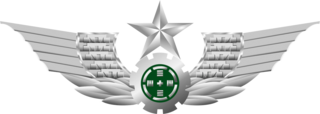
The 84th Training Command ("Railsplitters") is a formation of the United States Army. During World War I it was designated the 84th Division, American Expeditionary Forces; during World War II it was known as the 84th Infantry Division. From 1946 to 1952, the division was a part of the United States Army Reserve as the 84th Airborne Division. In 1959, the division was reorganized and redesignated once more as the 84th Division. The division was headquartered in Milwaukee in command of over 4,100 soldiers divided into eight brigades—including an ROTC brigade—spread throughout seven states.
Group armies or army groups or combined corps, are corps-level military formations of the People's Liberation Army Ground Force of China. Despite what the name suggests, current Group Armies are not army-level formations, but corps-sized formations commanding 12 to 14 brigades, roughly equivalent to United States Army Corps.

The Nanjing Military Region was one of the former seven military command regions for the Chinese People's Liberation Army. Its jurisdiction covers all military and armed police located in Anhui, Jiangsu, Zhejiang, Jiangxi, Fujian, and Shanghai. It also covers Taiwan, which is claimed by the People's Republic of China but administered by the Republic of China. The head of the region was Cai Yingting. This region is now part of the Eastern Theater Command.
The Battle of Xuzhou was fought in May 1938 as part of the Second Sino-Japanese War.

Qin Jiwei was a general of the People's Republic of China, Minister of National Defense and a member of the Chinese Communist Party Politburo.
The 60th Medium Combined Arms Brigade is one of the six combined arms brigades of the 83rd Group Army under the Central Theater Command. The 60th was converted from a division to a brigade as part of the PLA modernization efforts of the late 1990s.
The 199th Medium Combined Arms Brigade, formerly the 199th Motorized Infantry Brigade, is one of the six combined arms brigades of the 80th Group Army in the Northern Theater Command Ground Force.

The 72nd Group Army, Unit 31657, formerly the 1st Group Army, is a military formation of the Chinese People's Liberation Army Ground Forces (PLAGF). The 71st Group Army is one of thirteen total group armies of the PLAGF, the largest echelon of ground forces in the People's Republic of China, and one of three assigned to the nation's Eastern Theater Command. Headquartered in Huzhou, Zhejiang, the unit's primary mission is likely preparation for conflict in or about the Taiwan Strait.

The Eastern Theater Command is one of the five theater commands of the People's Liberation Army (PLA), founded 1 February 2016. It replaced the Nanjing Military Region. The command is headquartered in Nanjing.
The 7th Division (1st Formation) of the Chinese People's Liberation Army was created in February 1949 under the Regulation of the Redesignations of All Organizations and Units of the Army, issued by Central Military Commission on November 1, 1948, basing on the 2nd Independent Brigade, 3rd Column of the PLA Northwestern Field Army. Its history can be traced to the 358th Brigade(2nd Formation), 120th Division of Eighth Route Army, formed in April 1939.
The 11th Corps was a military formation of the Chinese People's Liberation Army. It was active from 1949 to 1952, with a six month break; and from 1969 to the end of 1985. It is currently inactive. In 1979 the corps took part in the Sino-Vietnamese War. In 1984 it again fought in Vietnam. It was stationed in the Kunming Military Region.
The First Field Army of the Chinese Communist Party was a military formation in the last stages of the Chinese Civil War (1949–1950).
The 11th Division was created in February 1949 under the Regulation of the Redesignations of All Organizations and Units of the Army, issued by Central Military Commission on November 1, 1948, basing on the 3rd Security Brigade, 4th Column of the PLA Northwest Field Army. Its composition can be traced to 84th Division of 27th Corps, Military Division of Shaanxi-Gansu, 29th Corps, Independent Division of Shanganning, 2nd Regiment of Shanganning, 1st Independent Division of Northern Shaanxi and Headquarters, 4th Corps, all parts of Chinese Workers' and Peasants' Red Army.
The 49th Infantry Division was a division of the Chinese People's Liberation Army. It was formed in March 1952 and in August designated as a light division of the national defense force. It was the second PRC infantry division numbered 49; the previous 49th Division had been disestablished in 1950-51.
The 73rd Division was created in February 1949 under the Regulation of the Redesignations of All Organizations and Units of the Army, issued by Central Military Commission on November 1, 1948, basing on the 19th Division, 7th Column of the Huadong Field Army. Its history can be traced to the Riverine Detachment of 7th Division, New Fourth Army, formed in February 1943.
The 92nd Division was created in February 1949 under the Regulation of the Redesignations of All Organizations and Units of the Army, issued by Central Military Commission on November 1, 1948,. basing on the 38th Division, 13th Column of the Huadong Field Army. Its history can be traced to the New 6th Division, Jiaodong Military District, formed in March 1947.
The 91st Division was created in February 1949 under the Regulation of the Redesignations of All Organizations and Units of the Army, issued by Central Military Commission on November 1, 1948,. basing on the 37th Division, 13th Column of the Huadong Field Army. Its history can be traced to the New 5th Division, Jiaodong Military District, formed in February 1947.

The Eastern Theater Command Ground Force is the ground force under the Eastern Theater Command. Its headquarters is in Fuzhou, Fujian. The current commander is Kong Jun and the current political commissar is Zhang Hongbing.







